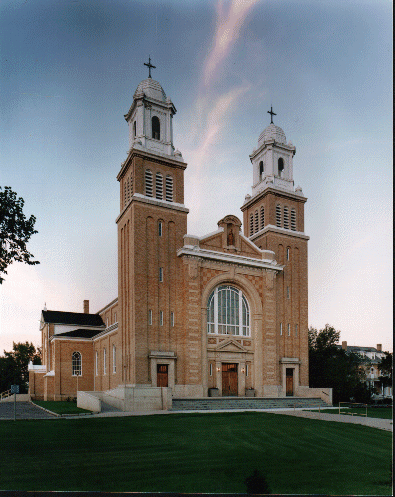
Mark Greschner MPA, Artec Photographic Design

| La Co-Cathédrale: Site historique
Le 26 mars 1987, le Conseil municipal de Gravelbourg désignait officiellement la Cathédrale Notre-Dame de l’Assomption de Gravelbourg comme SITE HISTORIQUE MUNICIPAL. Il reconnaissait ainsi l’importance historique, culturelle et architecturale de cet édifice, aux yeux de la communauté locale. En juillet 1995, la Commission des lieux et monuments historiques du Canada recommandait la désignation de SITE HISTORIQUE NATIONAL au ‘Complexe religieux de Gravelbourg’ qui comprend la cathédrale, l’évêché et la couvent Jésus-Marie dit Collège Thévenet. La Commission déclarait que ces ‘Édifices religieux de Gravelbourg’ sont d’importance historique et architecturale nationale et devraient être commémorés par une plaque dont le texte ferait ressortir les efforts de colonisation de l’Église Catholique plutôt que la valeur architecturale en soi de ces édifices…parce qu’ils symbolisent les efforts de l’Église Catholique dans l’Ouest du Canada en fin du 19e siècle et au début du 20e, ainsi que leur étroite association avec le travail de Louis-Joseph-Pierre Gravel. En plus, ces édifices issus du génie de Joseph-Ernest Fortin domicilié en Saskatchewan ont une qualité architecturale supérieure, autant dans leur style que dans leur sophistication stylistique, à ceux érigés dans d’autres colonies franco-catholiques à travers la prairie. |
The Co-Cathedral : An Historic
Site
On March 26, 1987, Gravelbourg Town Council empowered by the Heritage Property Act of 1981 passed a bylaw designating Our Lady of the Assumption Cathedral MUNICIPAL HERITAGE PROPERTY. Council was thereby giving recognition and protection to a structure of significant historical, cultural and architectural importance to the local community. In July of 1995, the Historic Sites and Monuments Board of Canada recommended that the cluster of buildings known as the `Gravelbourg Religious Complex`- comprising Our Lady of the Assumption Roman Catholic Cathedral, the Convent of Jesus and Mary (Thévenet College) and the Bishop’s Residence – be designated as a NATIONAL HISTORIC SITE. The Board advised that the Gravelbourg Ecclesiastical Buildings are of national historic and architectural signifacance and should be commemorated by means of a plaque, the text of which should emphasize the colonization efforts of the Catholic Church, rather than their architecture per se… because they symbolize the French colonization efforts of the Roman Catholic Church in Western Canada in the late 19th and 20th centuries, and because of their close association with the work of Father Louis-Joseph-Pierre Gravel. Further, the complex of buildings, the work
of Saskatchewan-based architect Joseph-Ernest Fortin, was deemed to be
of superior architectural quality, both in style and stylistic sophistication,
to those erected in other Franco-Catholic colonies dotting the prairies.
|